[English] 日本語
 Yorodumi
Yorodumi- PDB-6m1h: CryoEM structure of human PAC1 receptor in complex with maxadilan -
+ Open data
Open data
- Basic information
Basic information
| Entry | Database: PDB / ID: 6m1h | ||||||
|---|---|---|---|---|---|---|---|
| Title | CryoEM structure of human PAC1 receptor in complex with maxadilan | ||||||
 Components Components |
| ||||||
 Keywords Keywords | PROTEIN BINDING / GPCR | ||||||
| Function / homology |  Function and homology information Function and homology informationnegative regulation of response to reactive oxygen species / development of primary female sexual characteristics / vasoactive intestinal polypeptide receptor activity / positive regulation of cAMP-mediated signaling / NGF-independant TRKA activation / G protein-coupled peptide receptor activity / positive regulation of small GTPase mediated signal transduction / neuropeptide binding / positive regulation of inositol phosphate biosynthetic process / positive regulation of calcium ion transport into cytosol ...negative regulation of response to reactive oxygen species / development of primary female sexual characteristics / vasoactive intestinal polypeptide receptor activity / positive regulation of cAMP-mediated signaling / NGF-independant TRKA activation / G protein-coupled peptide receptor activity / positive regulation of small GTPase mediated signal transduction / neuropeptide binding / positive regulation of inositol phosphate biosynthetic process / positive regulation of calcium ion transport into cytosol / PKA activation in glucagon signalling / peptide hormone binding / adenylate cyclase binding / hair follicle placode formation / developmental growth / D1 dopamine receptor binding / bicellular tight junction / multicellular organismal response to stress / intracellular transport / renal water homeostasis / Hedgehog 'off' state / adenylate cyclase-activating adrenergic receptor signaling pathway / activation of adenylate cyclase activity / cellular response to glucagon stimulus / cAMP-mediated signaling / adenylate cyclase activator activity / regulation of insulin secretion / trans-Golgi network membrane / negative regulation of inflammatory response to antigenic stimulus / bone development / G-protein beta/gamma-subunit complex binding / Olfactory Signaling Pathway / caveola / adenylate cyclase-modulating G protein-coupled receptor signaling pathway / Activation of the phototransduction cascade / adenylate cyclase-activating G protein-coupled receptor signaling pathway / G beta:gamma signalling through PLC beta / Presynaptic function of Kainate receptors / Thromboxane signalling through TP receptor / G protein-coupled acetylcholine receptor signaling pathway / G protein activity / G-protein activation / platelet aggregation / Activation of G protein gated Potassium channels / Inhibition of voltage gated Ca2+ channels via Gbeta/gamma subunits / Prostacyclin signalling through prostacyclin receptor / Glucagon signaling in metabolic regulation / G beta:gamma signalling through CDC42 / cognition / G beta:gamma signalling through BTK / ADP signalling through P2Y purinoceptor 12 / small GTPase binding / Sensory perception of sweet, bitter, and umami (glutamate) taste / Synthesis, secretion, and inactivation of Glucagon-like Peptide-1 (GLP-1) / photoreceptor disc membrane / Glucagon-type ligand receptors / Adrenaline,noradrenaline inhibits insulin secretion / Vasopressin regulates renal water homeostasis via Aquaporins / G alpha (z) signalling events / vasodilation / Glucagon-like Peptide-1 (GLP1) regulates insulin secretion / cellular response to catecholamine stimulus / ADORA2B mediated anti-inflammatory cytokines production / sensory perception of taste / ADP signalling through P2Y purinoceptor 1 / G beta:gamma signalling through PI3Kgamma / adenylate cyclase-activating dopamine receptor signaling pathway / Cooperation of PDCL (PhLP1) and TRiC/CCT in G-protein beta folding / GPER1 signaling / cellular response to prostaglandin E stimulus / Inactivation, recovery and regulation of the phototransduction cascade / G-protein beta-subunit binding / heterotrimeric G-protein complex / sensory perception of smell / G alpha (12/13) signalling events / extracellular vesicle / signaling receptor complex adaptor activity / Thrombin signalling through proteinase activated receptors (PARs) / GTPase binding / response to estradiol / positive regulation of cold-induced thermogenesis / retina development in camera-type eye / signaling receptor activity / Ca2+ pathway / phospholipase C-activating G protein-coupled receptor signaling pathway / G alpha (i) signalling events / fibroblast proliferation / spermatogenesis / G alpha (s) signalling events / Hydrolases; Acting on acid anhydrides; Acting on GTP to facilitate cellular and subcellular movement / G alpha (q) signalling events / response to ethanol / Ras protein signal transduction / cell population proliferation / Extra-nuclear estrogen signaling / cell differentiation / receptor complex / cell surface receptor signaling pathway / endosome / response to xenobiotic stimulus Similarity search - Function | ||||||
| Biological species |  Homo sapiens (human) Homo sapiens (human)  Lutzomyia longipalpis (insect) Lutzomyia longipalpis (insect) | ||||||
| Method | ELECTRON MICROSCOPY / single particle reconstruction / cryo EM / Resolution: 3.6 Å | ||||||
 Authors Authors | Song, X. / Wang, J. / Zhang, D. / Wang, H.W. / Ma, Y. | ||||||
 Citation Citation |  Journal: Cell Res / Year: 2020 Journal: Cell Res / Year: 2020Title: Cryo-EM structures of PAC1 receptor reveal ligand binding mechanism. Authors: Jia Wang / Xianqiang Song / Dandan Zhang / Xiaoqing Chen / Xun Li / Yaping Sun / Cui Li / Yunpeng Song / Yao Ding / Ruobing Ren / Essa Hu Harrington / Liaoyuan A Hu / Wenge Zhong / Cen Xu / ...Authors: Jia Wang / Xianqiang Song / Dandan Zhang / Xiaoqing Chen / Xun Li / Yaping Sun / Cui Li / Yunpeng Song / Yao Ding / Ruobing Ren / Essa Hu Harrington / Liaoyuan A Hu / Wenge Zhong / Cen Xu / Xin Huang / Hong-Wei Wang / Yingli Ma /   Abstract: The pituitary adenylate cyclase-activating polypeptide type I receptor (PAC1R) belongs to the secretin receptor family and is widely distributed in the central neural system and peripheral organs. ...The pituitary adenylate cyclase-activating polypeptide type I receptor (PAC1R) belongs to the secretin receptor family and is widely distributed in the central neural system and peripheral organs. Abnormal activation of the receptor mediates trigeminovascular activation and sensitization, which is highly related to migraine, making PAC1R a potential therapeutic target. Elucidation of PAC1R activation mechanism would benefit discovery of therapeutic drugs for neuronal disorders. PAC1R activity is governed by pituitary adenylate cyclase-activating polypeptide (PACAP), known as a major vasodilator neuropeptide, and maxadilan, a native peptide from the sand fly, which is also capable of activating the receptor with similar potency. These peptide ligands have divergent sequences yet initiate convergent PAC1R activity. It is of interest to understand the mechanism of PAC1R ligand recognition and receptor activity regulation through structural biology. Here we report two near-atomic resolution cryo-EM structures of PAC1R activated by PACAP38 or maxadilan, providing structural insights into two distinct ligand binding modes. The structures illustrate flexibility of the extracellular domain (ECD) for ligands with distinct conformations, where ECD accommodates ligands in different orientations while extracellular loop 1 (ECL1) protrudes to further anchor the ligand bound in the orthosteric site. By structure-guided molecular modeling and mutagenesis, we tested residues in the ligand-binding pockets and identified clusters of residues that are critical for receptor activity. The structures reported here for the first time elucidate the mechanism of specificity and flexibility of ligand recognition and binding for PAC1R, and provide insights toward the design of therapeutic molecules targeting PAC1R. | ||||||
| History |
|
- Structure visualization
Structure visualization
| Movie |
 Movie viewer Movie viewer |
|---|---|
| Structure viewer | Molecule:  Molmil Molmil Jmol/JSmol Jmol/JSmol |
- Downloads & links
Downloads & links
- Download
Download
| PDBx/mmCIF format |  6m1h.cif.gz 6m1h.cif.gz | 212.6 KB | Display |  PDBx/mmCIF format PDBx/mmCIF format |
|---|---|---|---|---|
| PDB format |  pdb6m1h.ent.gz pdb6m1h.ent.gz | 170.9 KB | Display |  PDB format PDB format |
| PDBx/mmJSON format |  6m1h.json.gz 6m1h.json.gz | Tree view |  PDBx/mmJSON format PDBx/mmJSON format | |
| Others |  Other downloads Other downloads |
-Validation report
| Summary document |  6m1h_validation.pdf.gz 6m1h_validation.pdf.gz | 682.7 KB | Display |  wwPDB validaton report wwPDB validaton report |
|---|---|---|---|---|
| Full document |  6m1h_full_validation.pdf.gz 6m1h_full_validation.pdf.gz | 696.3 KB | Display | |
| Data in XML |  6m1h_validation.xml.gz 6m1h_validation.xml.gz | 35.3 KB | Display | |
| Data in CIF |  6m1h_validation.cif.gz 6m1h_validation.cif.gz | 54.5 KB | Display | |
| Arichive directory |  https://data.pdbj.org/pub/pdb/validation_reports/m1/6m1h https://data.pdbj.org/pub/pdb/validation_reports/m1/6m1h ftp://data.pdbj.org/pub/pdb/validation_reports/m1/6m1h ftp://data.pdbj.org/pub/pdb/validation_reports/m1/6m1h | HTTPS FTP |
-Related structure data
| Related structure data |  30047MC  6m1iC M: map data used to model this data C: citing same article ( |
|---|---|
| Similar structure data |
- Links
Links
- Assembly
Assembly
| Deposited unit | 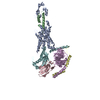
|
|---|---|
| 1 |
|
- Components
Components
-Protein , 2 types, 2 molecules AB
| #1: Protein | Mass: 47967.223 Da / Num. of mol.: 1 Source method: isolated from a genetically manipulated source Source: (gene. exp.)  Homo sapiens (human) / Production host: Homo sapiens (human) / Production host:  Insect BA phytoplasma (bacteria) / References: UniProt: P41586*PLUS Insect BA phytoplasma (bacteria) / References: UniProt: P41586*PLUS |
|---|---|
| #2: Protein | Mass: 6881.820 Da / Num. of mol.: 1 / Source method: obtained synthetically / Source: (synth.)  Lutzomyia longipalpis (insect) / References: UniProt: P30659 Lutzomyia longipalpis (insect) / References: UniProt: P30659 |
-Guanine nucleotide-binding protein ... , 3 types, 3 molecules DEF
| #4: Protein | Mass: 7861.143 Da / Num. of mol.: 1 Source method: isolated from a genetically manipulated source Source: (gene. exp.)  Homo sapiens (human) / Gene: GNG2 / Production host: Homo sapiens (human) / Gene: GNG2 / Production host:  Insect BA phytoplasma (bacteria) / References: UniProt: P59768 Insect BA phytoplasma (bacteria) / References: UniProt: P59768 |
|---|---|
| #5: Protein | Mass: 37473.980 Da / Num. of mol.: 1 Source method: isolated from a genetically manipulated source Source: (gene. exp.)  Homo sapiens (human) / Gene: GNB1 / Production host: Homo sapiens (human) / Gene: GNB1 / Production host:  Insect BA phytoplasma (bacteria) / References: UniProt: P62873 Insect BA phytoplasma (bacteria) / References: UniProt: P62873 |
| #6: Protein | Mass: 45683.434 Da / Num. of mol.: 1 Source method: isolated from a genetically manipulated source Source: (gene. exp.)  Homo sapiens (human) / Production host: Homo sapiens (human) / Production host:  Insect BA phytoplasma (bacteria) / References: UniProt: P63092*PLUS Insect BA phytoplasma (bacteria) / References: UniProt: P63092*PLUS |
-Antibody , 1 types, 1 molecules C
| #3: Antibody | Mass: 14714.320 Da / Num. of mol.: 1 Source method: isolated from a genetically manipulated source Source: (gene. exp.)   |
|---|
-Experimental details
-Experiment
| Experiment | Method: ELECTRON MICROSCOPY |
|---|---|
| EM experiment | Aggregation state: PARTICLE / 3D reconstruction method: single particle reconstruction |
- Sample preparation
Sample preparation
| Component | Name: PACAP38-PAC1R complex / Type: COMPLEX / Entity ID: all / Source: RECOMBINANT |
|---|---|
| Molecular weight | Value: 0.15 MDa / Experimental value: NO |
| Source (natural) | Organism:  Homo sapiens (human) Homo sapiens (human) |
| Source (recombinant) | Organism:  |
| Buffer solution | pH: 7.5 |
| Specimen | Conc.: 5 mg/ml / Embedding applied: NO / Shadowing applied: NO / Staining applied: NO / Vitrification applied: YES |
| Vitrification | Instrument: FEI VITROBOT MARK IV / Cryogen name: ETHANE / Humidity: 100 % |
- Electron microscopy imaging
Electron microscopy imaging
| Experimental equipment |  Model: Titan Krios / Image courtesy: FEI Company |
|---|---|
| Microscopy | Model: FEI TITAN KRIOS |
| Electron gun | Electron source:  FIELD EMISSION GUN / Accelerating voltage: 300 kV / Illumination mode: FLOOD BEAM FIELD EMISSION GUN / Accelerating voltage: 300 kV / Illumination mode: FLOOD BEAM |
| Electron lens | Mode: BRIGHT FIELD / Cs: 0 mm / C2 aperture diameter: 50 µm |
| Image recording | Electron dose: 50 e/Å2 / Detector mode: SUPER-RESOLUTION / Film or detector model: GATAN K2 SUMMIT (4k x 4k) |
| Image scans | Width: 3838 / Height: 3710 |
- Processing
Processing
| EM software |
| ||||||||||||||||||||
|---|---|---|---|---|---|---|---|---|---|---|---|---|---|---|---|---|---|---|---|---|---|
| CTF correction | Type: PHASE FLIPPING AND AMPLITUDE CORRECTION | ||||||||||||||||||||
| Symmetry | Point symmetry: C1 (asymmetric) | ||||||||||||||||||||
| 3D reconstruction | Resolution: 3.6 Å / Resolution method: FSC 0.143 CUT-OFF / Num. of particles: 58451 / Algorithm: BACK PROJECTION / Num. of class averages: 1 / Symmetry type: POINT | ||||||||||||||||||||
| Atomic model building | PDB-ID: 5B16 |
 Movie
Movie Controller
Controller




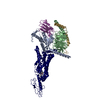


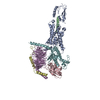

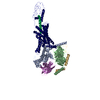

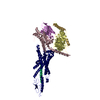
 PDBj
PDBj






















